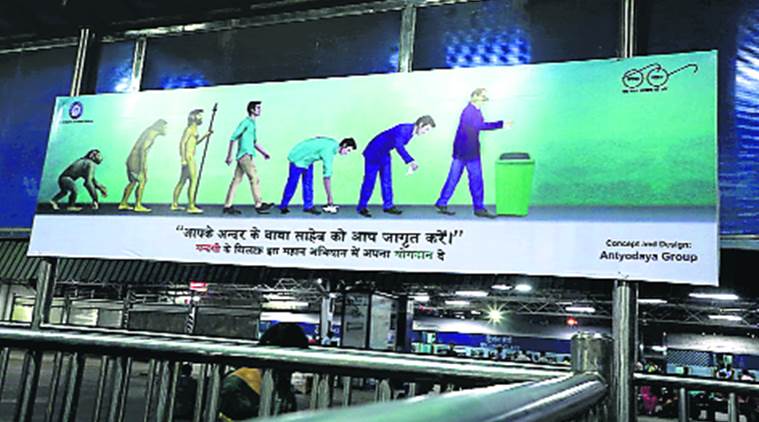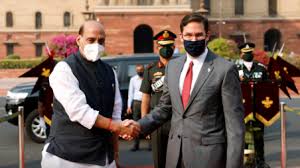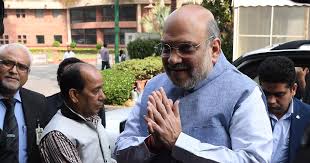Feature
Railways removes poster showing B R Ambedkar picking trash

New Delhi: Controversy arises after Posters showing B R Ambedkar picking up and throwing trash into a dustbin was seen in New Delhi Railway station, However later posters were removed after there were fury in political parties and Dalit activists, who alleged he was being depicted as a “manual scavenger”.
The hoarding was part of a series of posters put by the private company, Antyodaya Group, which had approached the Railways for the campaign and had done it for free. The plan was to use national icons to educate people.
The caption underneath read: “Awaken the Babasaheb within you. Contribute to this great campaign against filth.” A second poster depicted a WhatsApp conversation in which a woman is asked by her friend why her family objects to her meeting male friends, when they have no apprehensions letting her defecate in the open.
A third, also in the form of a WhatsApp conversation, talks about a man being bitten by a snake while defecating in the open.
Since the controversy, Railways authorities have taken down all posters, including of other ‘icons’ such as Gandhi and the film character Bahubali. Antyodaya Group founder Sourav Panda (26) denied the BSP’s charge that his company had links with the RSS. He said he had been so “inspired by Ambedkar” that he had “given up wearing the sacred thread”.
“By removing the posters, they have removed Ambedkar’s drastic thoughts. The idea behind Swachh Bharat is as drastic as anything that Ambedkar represented. I didn’t think of any political colouring while designing the poster. The idea was to push awareness in people,” he told media.
Railway authorities, meanwhile, pinned the blame on Panda and his year-old organisation, accusing him of “unauthorisedly” putting up posters “with icons”.
In a statement, R N Singh, divisional railway manager, Delhi, said, “Limited permission was given to NGO Antyodaya to put out a few stickers/slogans at New Delhi railway station with the noble objective of enhancing cleanliness awareness amongst public.
They were allowed to put only simple messages regarding cleanliness awareness like ‘keep the station clean’, ‘take ownership over the station’. Instead, they unauthorisedly put out a poster with icons. We removed all posters immediately. We are contemplating suitable action. In the future, we will do all awareness campaigns in-house only.”
The controversy erupted on Thursday, weeks after the hoarding had been put up, after BSP-led protesters chanted slogans in front of the station against the “casteist depiction” of Ambedkar. BSP’s social media handler Devashish Jaraiya described the advertisement campaign as “betraying” the “ignorance” of those who came up with it.
He said, “We got to know about the posters through social media and we held a protest. Showing Babasaheb throwing trash goes against the entire ideology that he represented.
The community has been associated with sanitation jobs for hundreds of years and continue to work in the same jobs. His entire ideology was to give this up, enter the education system and become nurses, doctors and lawyers.”
However, Panda denied any “angle of manual scavenging” and said that the idea behind putting up the posters at the New Delhi railway station was to maximise the campaign’s reach. “It was a trial phase and in the future, we plan to use Maharana Pratap’s image in Rajasthan, Subhash Chandra Bose’s image in Kolkata and also Bahubali because of his association with greatness in popular culture.”
Dalit activist Jignesh Mevani targeted the Swachh Bharat campaign, saying, “Even when the campaign was started, this casteist ethos was visible in Delhi. The state of Delhi and concerned authorities need to take cognizance of this and pay heed to the sentiments of Dalit masses.”
Entertainment
Meghalaya Reserves Legalized Gambling and Sports Betting for Tourists

The State Scores Extra High on Gaming-Friendly Industry Index
Meghalaya scored 92.85 out of 100 possible points in a Gaming Industry Index and proved to be India’s most gaming-friendly state following its recent profound legislation changes over the field allowing land-based and online gaming, including games of chance, under a licensing regime.
The index by the UK India Business Council (UKIBC) uses a scale of 0 to 100 to measure the level of legalisation on gambling and betting achieved by a state based on the scores over a set of seven different games – lottery, horse racing, betting on sports, poker, rummy, casino and fantasy sports
Starting from February last year, Meghalaya became the third state in India’s northeast to legalise gambling and betting after Sikkim and Nagaland. After consultations with the UKIBC, the state proceeded with the adoption of the Meghalaya Regulation of Gaming Act, 2021 and the nullification of the Meghalaya Prevention of Gambling Act, 1970. Subsequently in December, the Meghalaya Regulation of Gaming Rules, 2021 were notified and came into force.
All for the Tourists
The move to legalise and license various forms of offline and online betting and gambling in Meghalaya is aimed at boosting tourism and creating jobs, and altogether raising taxation revenues for the northeastern state. At the same time, the opportunities to bet and gamble legally will be reserved only for tourists and visitors.
“We came out with a Gaming Act and subsequently framed the Regulation of Gaming Rules, 2021. The government will accordingly issue licenses to operate games of skill and chance, both online and offline,” said James P. K. Sangma, Meghalaya State Law and Taxation Minister speaking in the capital city of Shillong. “But the legalized gambling and gaming will only be for tourists and not residents of Meghalaya,” he continued.
To be allowed to play, tourists and people visiting the state for work or business purposes will have to prove their non-resident status by presenting appropriate documents, in a process similar to a bank KYC (Know Your Customer) procedure.
Meghalaya Reaches Out to a Vast Market
With 140 millions of people in India estimated to bet regularly on sports, and a total of 370 million desi bettors around prominent sporting events, as per data from one of the latest reports by Esse N Videri, Meghalaya is set to reach out and take a piece of a vast market.
Estimates on the financial value of India’s sports betting market, combined across all types of offline channels and online sports and cricket predictions and betting platforms, speak about amounts between $130 and $150 billion (roughly between ₹9.7 and ₹11.5 lakh crore).
Andhra Pradesh, Telangana and Delhi are shown to deliver the highest number of bettors and Meghalaya can count on substantial tourists flow from their betting circles. The sports betting communities of Karnataka, Maharashtra, Uttar Pradesh and Haryana are also not to be underestimated.
Among the sports, cricket is most popular, registering 68 percent of the total bet count analyzed by Esse N Videri. Football takes second position with 11 percent of the bets, followed by betting on FIFA at 7 percent and on eCricket at 5 percent. The last position in the Top 5 of popular sports for betting in India is taken by tennis with 3 percent of the bet count.
Local Citizens will Still have Their Teer Betting
Meghalaya residents will still be permitted to participate in teer betting over arrow-shooting results. Teer is a traditional method of gambling, somewhat similar to a lottery draw, and held under the rules of the Meghalaya Regulation of the Game of Arrow Shooting and the Sale of Teer Tickets Act, 2018.
Teer includes bettors wagering on the number of arrows that reach the target which is placed about 50 meters away from a team of 20 archers positioned in a semicircle.
The archers shoot volleys of arrows at the target for ten minutes, and players place their bets choosing a number between 0 and 99 trying to guess the last two digits of the number of arrows that successfully pierce the target.
If, for example, the number of hits is 256, anyone who has bet on 56 wins an amount eight times bigger than their wager.
























